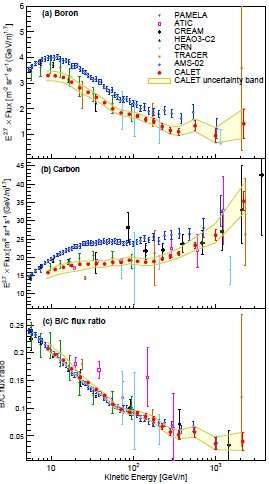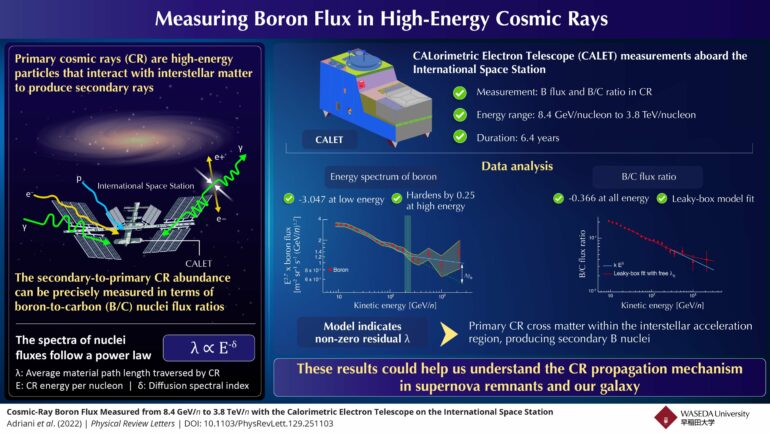Cosmic rays (CR) constitute high-energy particles that mainly originate outside our solar system. These primary CR interact with interstellar matter to produce secondary CR. The secondary nature of their origin is reflected in the higher abundance of light elements, such as boron (B), in secondary CR relative to the solar system.
Likewise, the primary CR can be quantified in terms of the amount of carbon (C) nuclei. Consequently, measurements of the secondary-to-primary abundance ratios (as B/C) are possible. This can help realize better galactic CR propagation models by constraining their parameters that are proportional to the average material path length (λ) traversed by CR in the galaxy at high energies.
Existing studies indicate that λ follows a power-law variation. It is inversely related to E raised to the δth power, where E is the CR energy per nucleon and δ is called the diffusion spectral index. The galactic CR propagation can be investigated by precisely determining the energy dependence of λ.
In this regard, a team of international researchers, led by Professor Emeritus Shoji Torii from Waseda University, Japan, has now extended the measurements of secondary CR in the tera electronvolts/nucleon (TeV/n) region with high statistics and reduced systematic uncertainties. Their work, published in Physical Review Letters on December 16, 2022, involved contributions from Dr. Paolo Maestro from the University of Siena, Italy, and Dr. Yosui Akaike from Waseda University.

(a) Boron and (b) carbon flux (multiplied by E2.7) and (c) ratio of boron to carbon, as a function of kinetic energy, E. While the error bars of CALET data (in red) represent only the statistical uncertainty, the yellow band indicates the quadratic sum of statistical and systematic errors. © Yosui Akaike of Waseda University, Japan
Akaike briefly discusses the fundamental contribution of their study. “Our research presents new direct measurements of the energy spectrum of B and the B/C flux ratio in the energy range 8.4 GeV/n to 3.8 TeV/n, based on the data collected by the CALorimetric Electron Telescope (CALET) from October 13, 2015, to February 28, 2022 aboard the International Space Station. The C energy spectrum has also been updated. The measurements indicate excellent charge identification, accurate tracking, and good energy sampling of the CR particles up to the TeV region,” he says.
By analyzing the CALET data, the researchers observed that B shows a different energy spectrum from C in terms of its spectral index value: -3.047 for low energies. The index seems to harden (by 0.25) more than it does for C (by 0.19), albeit with low statistical significance, at a transition energy of around 200 GeV/n. The B/C ratio can be fitted with a single power law function with a spectral index of -0.366, even at high energies.
Further, due to the slight difference in the hardening between B and C, the researchers tried to fit a “leaky-box model” of CR propagation in the galaxy to the B/C ratio. In this approach, the CR were modeled as “leaking” from the galaxy. Their results pointed to the possibility of a non-zero residual value of λ. Physically, this implies that the primary CR cross a column density of matter within the acceleration region. They then produce new secondary B nuclei near the CR source, hardening the ratio.
“The presented results could significantly contribute to our understanding of cosmic ray propagation mechanism in supernova remnants and our galaxy. More importantly, however, pure science research can stimulate an intellectual curiosity about our universe and help us better comprehend what life might look like at places like the Moon and Mars,” concludes Akaike.
More information:
O. Adriani et al, Cosmic-Ray Boron Flux Measured from 8.4 GeV/n to 3.8 TeV/n with the Calorimetric Electron Telescope on the International Space Station, Physical Review Letters (2022). DOI: 10.1103/PhysRevLett.129.251103
Citation:
Researchers measure boron flux in high-energy cosmic rays with the CALorimetric Electron Telescope (CALET) (2023, January 26)
